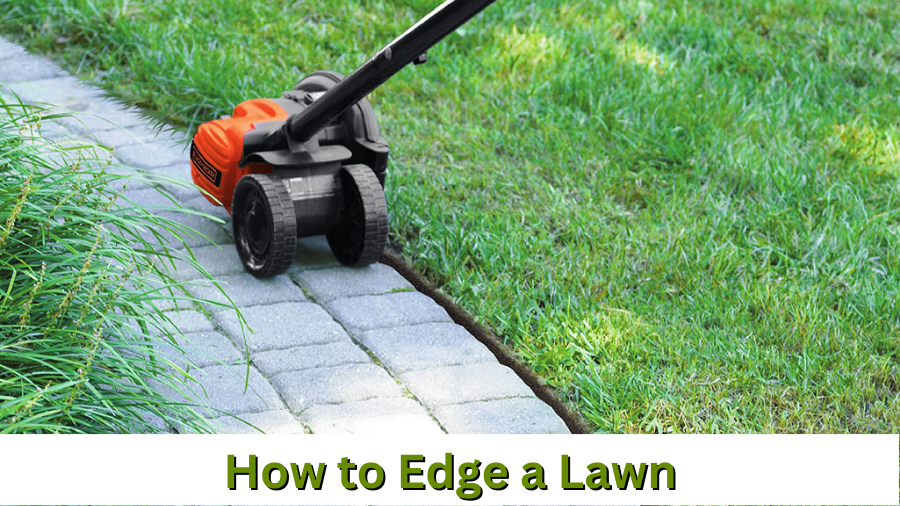Keeping a well-manicured lawn requires regular maintenance, and one of the most important tasks is edging. Edging helps define your lawn’s boundaries and create a clean, polished look.
This guide will walk you through how to edge a lawn and provide tips and tools to make the job easier.
Mow Your Lawn
Before you begin edging, it’s important to mow your lawn first. This will make it easier to see the edges of your lawn and ensure you’re cutting away the right amount of grass.
Make sure to mow your lawn to the desired height, and be sure to leave a little extra length on the edges to make them more visible.
First, ensure the mower blade is sharp and in good working condition. A dull blade will tear the grass, leaving a ragged edge and making it more difficult to edge neatly.
Also, a sharp blade will help you have a better cut and cleaner lawn surface.
Next, mow your lawn to the desired height. The ideal mowing height will vary depending on the grass type, but generally, it’s best to leave the grass a little longer on the edges.
This will make the edges more visible and ensure you don’t accidentally cut away too much grass.
When you’re ready to mow, start at one end of the lawn and work toward the other. Make sure to overlap each pass slightly to ensure you’re cutting all the grass.
Be sure to move slowly and pay attention to your mower’s blade to ensure you’re cutting the right amount of grass.
Another tip is to vary your mowing pattern instead of always mowing in the same direction every time, this will prevent the grass from leaning in one direction and will also help in preventing soil compaction.
Additionally, it’s also important to keep an eye on the weather forecast before mowing. If it’s going to be hot and dry, it’s best to mow your lawn in the early morning or evening when the grass is cooler and more hydrated. This will help prevent lawn damage and make it easier to edge.
Edging & Trimming Tools
There are a few options to choose from when it comes to edging tools. The most common tools used for edging are a manual edger or a power edger.
A manual edger is a hand-held tool with a blade that is pushed along the edge of the lawn.
A power edger, on the other hand, is a machine that is powered by gas or electricity and is typically more efficient.
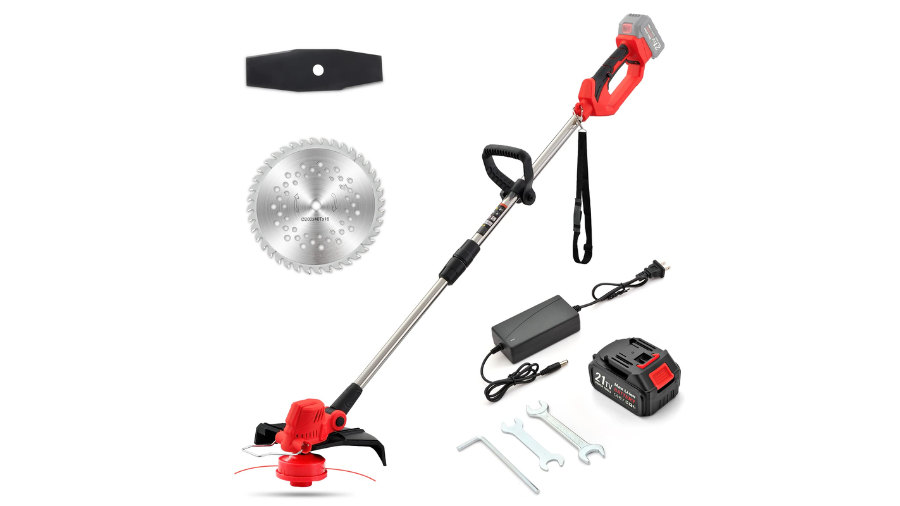
In addition to an edging tool, you’ll also need a pair of shears or a trimmer for cutting away any grass or weeds that have grown over the edge of the lawn.
There are a variety of tools available that can help you achieve a neat and clean edge on your lawn. Here are a few popular options:
- Manual Lawn Edger: A manual lawn edger is a hand-held tool that creates a crisp edge between the lawn and a paved surface, such as a driveway or sidewalk. They typically have a long handle and a blade at the bottom that cuts into the soil. This is a good option for small lawns or for those who prefer a more hands-on approach.
- Electric or Gas-Powered Lawn Edger: Electric or gas-powered lawn edgers are similar to manual edgers but powered by electricity or gas. These tools are more powerful and can quickly edge a large lawn. They are also great for those with physical limitations that make using a manual edger difficult.
- String Trimmer: A string trimmer is a handheld tool that uses a spinning line to cut through grass and weeds. They are great for cutting grass along a paved surface or around trees and other obstacles. String trimmers are also useful for cutting grass around flowerbeds and other landscaping features.
- Bed redefiner: A bed redefiner is a powered machine that cuts through the soil to redefine the edge of a flowerbed, walkway, or driveway. This tool is great for creating a clean and defined edge between the lawn and other landscaping features.
- Half-moon edger: This tool creates a defined edge between the lawn and the bed. It has a curved blade that cuts into the soil and the edge of the lawn, it’s a great option for creating a curved edge.
It’s important to note that some of these tools may require more maintenance and storage space than others.
It also depends on the size of your lawn, the layout of your property, and your personal preferences.
Electric or gas-powered tools are generally more powerful and efficient than manual tools, but they also require more maintenance and can be more expensive.
The best tool for edging your lawn will depend on your specific needs and preferences. A manual lawn edger, electric or gas-powered lawn edger, string trimmer, bed redefiner, and half-moon edger are all great options for achieving a neat and clean edge on your lawn.
Plan The Path
Before you start edging, it’s important to plan the path you will take. This will help you be more efficient and ensure you don’t miss any spots.
Start by marking the edges of your lawn with a piece of chalk or spray paint. Then, divide the area into sections and work on one section at a time.
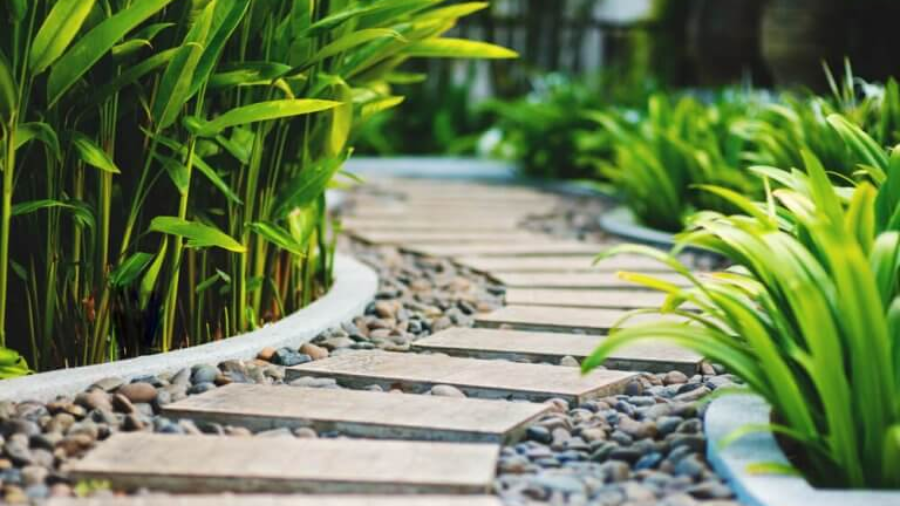
When you’re ready to begin edging, start at one end of the lawn and work toward the other.
Be sure to move slowly and pay attention to the blade of your edger to ensure that you’re cutting the right amount of grass.
As you work, be sure to stop and clean your edger blade frequently to prevent clogging.
Tips & Tricks
- Always wear safety gear, such as safety glasses and gloves, when using power tools.
- When edging, use a slow and steady pace to ensure a clean and even cut.
- If you’re using a manual edger, be sure to angle the blade slightly toward the lawn. This will help to ensure that the edge of the lawn is clean and even.
- If you notice that the edge of your lawn is uneven, use a garden rake to level it out before edging.
- Use a string line to guide your edging if you have a curved lawn. This will help to ensure that your edges are straight and even.
- After edging, use a leaf blower to clean up any debris.
With these tips and tricks in mind, you can edge your lawn like a pro. Remember to take your time and work carefully to ensure a clean and polished look. Your lawn will be the envy of the neighborhood in no time!
Using a Lawn Edger
Edging a lawn using a lawn edger is a simple process that can help to give your lawn a neat and tidy appearance. Here are some steps to follow when using a lawn edger:

- Mow your lawn: Before you begin edging, mowing your lawn first is important. This will help make the edges of your lawn more visible and ensure you’re cutting away the right amount of grass.
- Mark the edge: Use a stick or spray paint to mark the edge of the lawn where you want to cut. This will help you see where you need to cut and ensure you’re cutting the right amount of grass.
- Assemble your edger: Assemble your edger according to the manufacturer’s instructions. Ensure that the blade is securely attached and that all the necessary safety guards are in place.
- Start the engine: If you’re using a gas-powered edger, follow the manufacturer’s instructions. If you’re using an electric edger, make sure that it’s plugged in and turned on.
- Begin cutting: Position the edger at the edge of the lawn, where you marked it. Use the blade to cut into the soil at a slight angle, so that the blade is cutting into the grass as well. This will help create a clean edge between the lawn and the pavement or other landscaping features.
- Work your way along the edge: Move the edger along the edge of the lawn, keeping the blade at a slight angle and cutting into the soil and grass. Be sure to overlap each pass to ensure you’re cutting all the grass.
- Be careful around obstacles: Be careful when cutting around obstacles such as trees, flowerbeds, and other landscaping features. You may need to use a string trimmer or hand-held shears to cut around these obstacles.
- Clean up the debris: Once you’ve finished edging, clean up any debris that may have been left behind.
- Maintain your edger: After use, make sure to maintain your edger. Follow the manufacturer’s instructions for cleaning and storing the tool.
Safety Tips
How to Edge a Lawn Using a Lawn Edger – Safety Tips:
– Wear appropriate clothing and gear (long pants, closed-toe shoes, safety goggles)
– Use ear protection
– Follow the manufacturer’s instructions
– Inspect the tool before use
– Keep the area clear
– Turn off the tool when not in use
– Be aware of your surroundings (watch out for children and pets, obstacles)
– Exercise caution and use common sense when using any power tools
Using String trimmer
Edging a lawn using a string trimmer is a quick and easy way to give your lawn a neat and tidy appearance. Here are the steps to follow when using a string trimmer for lawn edging:
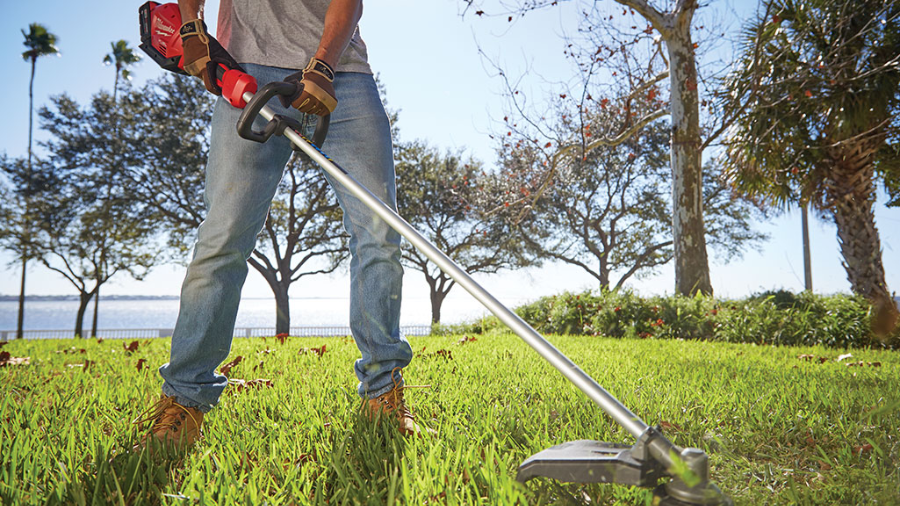
- Mow your lawn: Before you begin edging, mowing your lawn first is important. This will help make the edges of your lawn more visible and ensure you’re cutting away the right amount of grass.
- Mark the edge: Use a stick or spray paint to mark the edge of the lawn where you want to cut. This will help you stay on track and ensure a clean, straight edge.
- Adjust the cutting head: Adjust the cutting head of the string trimmer to the correct height. This will depend on the grass type you have and your edge’s desired height.
- Hold the trimmer securely: Hold the trimmer securely with both hands, one hand on the handle and the other on the trigger. This will give you better control and stability while cutting.
- Use a slow and steady motion: Use a slow and steady motion to cut along the marked edge. Be careful not to damage the edge of your lawn by cutting too deep.
- Check the trimmer’s line: Check the trimmer’s line regularly and replace it when worn. A dull or worn line can make cutting and damaging the lawn difficult.
- Wear appropriate safety gear: Always wear appropriate safety gear, such as eye, ear and mouth protection when using a string trimmer.
- Keep the trimmer in good working condition: Regularly maintain and keep the trimmer in good working condition. This will make the job easier and safer.
Tips For Best Practices When Edging Using A String Trimmer
– Mow the lawn before starting
– Mark the edge of the lawn where you want to cut
– Adjust the trimmer’s cutting head to the correct height
– Hold the trimmer securely with both hands
– Use a slow and steady motion to cut along the marked edge
– Be careful not to damage the edge of your lawn
– Check the trimmer’s line regularly and replace when worn
– Wear appropriate safety gear (eye, ear and mouth protection)
– Exercise caution when using the tool.
– Keep the trimmer in good working condition
– Keep the area clear of debris and obstacles
– Use the right line size for the task
– Angle the trimmer head slightly down
– Stand with your weight on your front foot while edging.
Using a Manual Edger
Edging a lawn using a manual edger may take a bit more time and effort than using a power tool, but it is a great way to get a precise and crisp edge for your lawn. Here’s how you can do it:
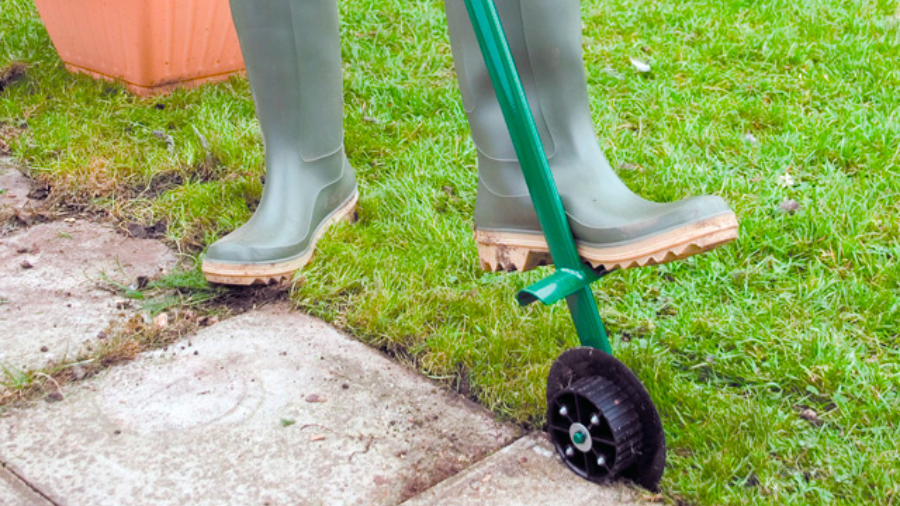
- Prep your lawn: Before you begin edging, it’s important to mow your lawn first and remove any debris or obstacles from the area you’ll be working on. This will make the edging process easier and safer.
- Mark the edge: Use a stick or spray paint to mark the edge of the lawn where you want to cut. This will help you stay on track and ensure a clean, straight edge.
- Choose the right edger: There are different types of manual edgers available, such as half-moon edgers, border edgers, and flat edges. Choose the one that is best suited for the type of edge you want to create.
- Start edging: Hold the edger securely with both hands and use a steady and consistent motion to cut along the marked edge. Push the edger into the soil to make a clean cut, but be careful not to damage the edge of your lawn by cutting too deep.
- Check the blade: Check the blade of the edger regularly and sharpen it if necessary. A dull blade will make it harder to cut and may damage your lawn.
- Finish the edge: Once you have completed the edging, use a rake or a broom to remove any debris or loose soil from the edge of your lawn.
- Repeat the process: Repeat the edging process at regular intervals, such as every 2-4 weeks, to maintain a neat and tidy edge for your lawn.
By following these steps, you can achieve a precise and professional-looking edge for your lawn using a manual edger. Remember to always use caution and good judgment when using any manual tools.
Trimmers Vs. Edgers
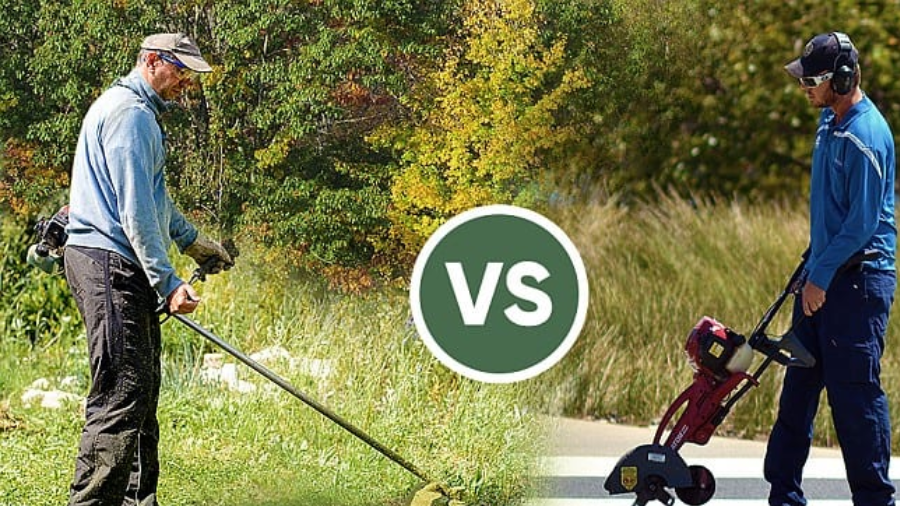
- Purpose: Trimmers are primarily used for cutting grass and weeds along hard-to-reach areas such as fences, walls, and around trees, while edgers are designed for creating a clean and defined edge along sidewalks, driveways, and flower beds.
- Design: Trimmers typically have a curved or angled cutting head that can be adjusted to different positions, while edgers have a straight and vertical cutting head.
- Power source: Trimmers can be powered by electricity, battery, or gasoline, while edgers are mostly powered by electricity.
- Cutting width: Trimmers have a narrow cutting width, typically less than an inch, while edgers have a wider cutting width of up to 2 inches.
- Cutting depth: Trimmers can cut at varying depths, while edgers have a fixed cutting depth.
- Price: Trimmers are generally more affordable than edgers.
- Maintenance: Trimmers may require more frequent maintenance, such as replacing the string, while edgers may require less maintenance.
- Safety: Trimmers can be more dangerous to use, especially with the fast-moving cutting string, while edgers have a more defined cutting blade.
Both trimmers and edgers are valuable tools for maintaining your lawn, but depending on your needs and preferences, one may be more suitable than the other.
It’s important to consider the specific tasks you need to accomplish and the most important features before deciding.
Why Edging Your Lawn is Important
Edging your lawn is important for several reasons. It helps create a clean boundary between your lawn and other landscaping elements such as sidewalks, driveways, and flower beds.
This gives your lawn a neat and tidy appearance and enhances the overall look of your landscape. Additionally, edging your lawn helps to keep grass and weeds from creeping into these areas, making it easier to maintain the edge over time.
Furthermore, edging your lawn can improve the health of your lawn by allowing air, water, and nutrients to reach the roots of the grass more easily.
In summary, regular edging of your lawn is important for aesthetic appeal, maintenance, and lawn health.
Lawn Edging Maintenance Tips
- Regular edging: Regularly edging your lawn at least once a month will help to maintain a clean and defined edge and prevent grass and weeds from encroaching into other landscaping elements.
- Use the right tools: Using the right tools, such as a manual or a powered edger, can make the job of edging your lawn much easier and more efficient.
- Cut at the right time: The best time to edge your lawn is when the grass is dry. This makes it easier to cut cleanly and gives you a more defined edge.
- Be careful not to over-edge: Over-edging can damage the roots of your lawn, making it more susceptible to disease and pests. Be sure only to edge the lawn as much as needed to maintain a clean edge.
- Keep the edge defined: After edging, use a rake or a stiff-bristled broom to remove any debris and to keep the edge defined.
- Mulch the clippings: Instead of throwing them away, use them as mulch around your plants. It will help to retain moisture and suppress weeds.
- Check the weather: Avoid edging your lawn when the ground is too wet or when it’s too hot. This could damage the lawn, and it could be dangerous for you.
- Safety first: Always wear appropriate safety gear and know your surroundings when using power tools.
By following these lawn edging maintenance tips, you can keep your lawn neat, tidy, and well-maintained. Regular edging is important for maintaining your lawn’s aesthetic appeal and health.
Additionally, it is important to use the right tools, time well, avoid over-edging, to keep the edge defined, mulch the clippings, check the weather, and always prioritize safety.
Practice Makes Edging Perfect
How should I start?
Follow these steps (i personally recommend it)
- Start with small areas: If you’re new to edging, start with small areas of your lawn to get a feel for the process and improve your technique.
- Take your time: Rushing through the edging process can lead to uneven edges and mistakes. Take your time and be patient as you learn.
- Pay attention to the angle: The angle at which you hold the edging tool can greatly impact the final result. Practice holding the tool at different angles to find the one that works best for you.
- Use a guide: A guide, such as a piece of wood or a hose, can help you to create a straight edge. Use it as a guide to help you stay on track as you edge.
- Practice different techniques: There are many different edging techniques that you can use, such as the slice and flip method or the push and pull method. Try out different techniques to find the one that works best for you.
- Take breaks: Edging can be physically demanding, so take breaks as needed to rest your arms and hands.
- Re-visit the areas you’ve edged: After you’ve finished edging an area, take a step back and revisit it. Look for any areas that need touch-ups or adjustments.
- Be consistent: Keep practicing and be consistent with your technique, and you can edge your lawn like a pro.
Practicing and following these tips can improve your edging technique and create a neat and tidy lawn.
Remember to take your time, pay attention to the angle, use a guide, practice different techniques, take breaks, re-visit the areas you’ve edged, be consistent and most importantly have patience. With practice, you can edge your lawn like a pro.
Cheers, we have done it.
Now move to the last part and most important part.
Clean the lawn
Other
Clean up
Clean-up is an essential step in completing any edging or trimming job. It’s not just about having a polished and professional-looking lawn; it also helps maintain your lawn’s overall health and appearance.
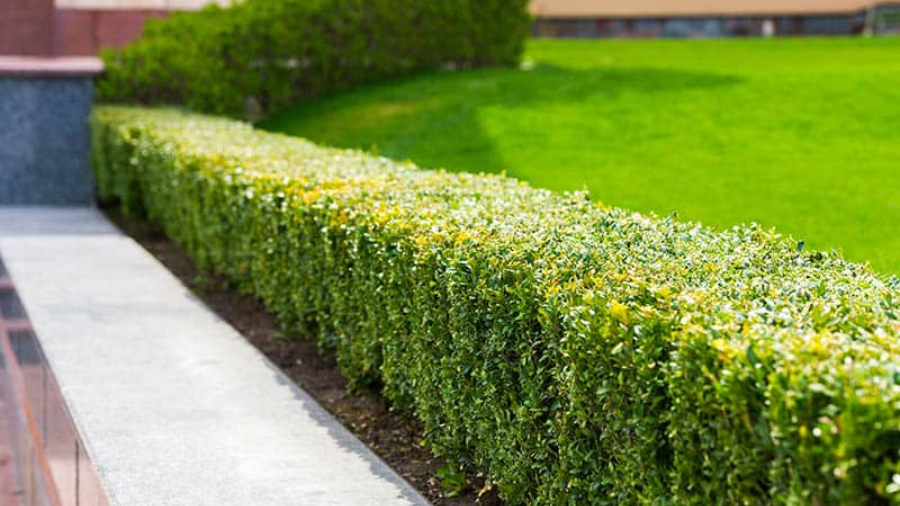
Follow these steps…
- Collect the debris: After you’ve finished edging, use a rake or a broom to collect the debris, such as grass clippings and soil.
- Dispose of the debris: The debris should be disposed of in a compost pile or in a green waste bin.
- Clean the edging tools: After you’ve finished edging, clean the tools that you used. This will help to prolong their lifespan and keep them in good working order.
- Store the tools properly: Once the tools are clean, store them in a dry, protected area.
- Inspect the lawn: After clearing the debris, take a step back and inspect the lawn. Look for any areas that need further attention or touch-ups.
- Keep the area tidy: Make sure to keep the area tidy by removing any leaves, twigs or other debris that may have accumulated on the lawn.
- Repeat the process: Edging is not a one-time task, it should be done regularly to maintain the neat and tidy look of the lawn.
By cleaning up the area after edging, you will not only keep your lawn looking neat and tidy, but also prolong the life of your tools, help the environment by disposing of the debris properly, and ensure that your lawn stays in great shape.
Remember to collect the debris, dispose of it properly, clean the tools, store the tools properly, inspect the lawn, keep the area tidy, and repeat the process regularly.
Good maintenance will help you to keep your lawn looking great all season long.
Also Read:
- How to Fix a Backfiring Lawn Mower
- How Often Should You Mow Your Lawn?
- Best Zero-Turn Lawn Mowers of 2023
Conclusion
As a pro landscaper, I can confidently say that a well-maintained lawn with crisp, clean edges can make all the difference in the overall appearance of your outdoor living space.
The process may seem daunting at first, but with the right tools, a little practice, and a bit of patience, you’ll be edging your lawn like a pro in no time.
So, get out there and give your lawn the edge it deserves. The result will be a lawn that is the envy of the neighborhood.
To sum up, lawn edging is an art, and by following the steps, tips, and tricks I’ve outlined in this guide, you’ll be able to create a masterpiece of your own.
A perfectly edged lawn is not only pleasing to the eye, but it’s also essential for the health and longevity of your lawn.
So, don’t wait, grab your tools and get ready to experience the satisfaction of a perfectly edged lawn.
FAQs
Q: How do you manually edge a lawn?
A: To manually edge a lawn, use a manual edging tool such as a half-moon edger or a flat-edge spade to create a clean edge along sidewalks, driveways, and other hard surfaces.
Q: How can I edge my lawn without an edger?
A: Lawn edging can also be done without an edger using a string trimmer or a manual edging tool, such as a half-moon or flat-edge spade.
Q: When should you edge your lawn?
A: The best time to edge a lawn is when the grass is dry and the soil is moist, typically in the spring or fall.
Q: Is edging a lawn necessary?
A: Yes, Edging a lawn is necessary for maintaining the overall appearance of your lawn.
Q: Can you edge a lawn by hand?
A: You can hand edge a lawn using manual edging tools such as a half-moon edger or flat-edge spade.
